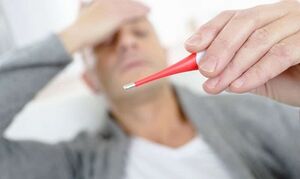Prostatitis is an inflammatory disease of the prostate that is often diagnosed in older men. The initial or first signs of prostatitis are quite specific, which allows you to detect the pathology in a timely manner, undergo a comprehensive examination and start treatment.
Types of diseases and first signs

There are two forms of the disease - bacterial (infectious) prostatitis and non-bacterial congestive prostatitis. The first signs of the disease directly depend on the nature of the inflammation.
In the first case, the cause of the disease is an infection, often inflammation caused by the action of bacterial agents that are transmitted sexually. This form of prostatitis is characterized by an ascending or descending route of prostate infection - the infection enters through the urethra or from the kidneys. The symptoms of inflammation are acute, they increase rapidly, and fever is often present.
Non-infectious prostatitis is a disease of office workers and men over the age of 50. The disease develops due to congestion in the pelvic area. The cause of inflammation is a violation of the microcirculation of blood in the prostate, stagnation of secretions in the organ and violation of trophism in the tissues of the prostate. The characteristic features of this form of inflammation are a slow increase in symptoms, often a latent course. If with the bacterial form of the disease the deterioration of well-being occurs rapidly, then noninfectious prostatitis rarely bothers in the early stages, making it difficult to diagnose the disease in a timely manner.
Common symptoms of prostatitis
Regardless of the form of the disease, the symptoms of prostatitis in men are as follows:
- pain when urinating;
- discomfort in the anus;
- incomplete bladder emptying;
- weakened urine pressure;
- frequent urge to spend the night in the toilet;
- general malaise;
- weakening of erection;
- violation of ejaculation;
- pain during ejaculation.
It is impossible to unambiguously answer the question of how exactly the initial phase of prostatitis manifests. Each patient has different symptoms at the beginning of the disease. This is due to the characteristics of the organism.
In most cases, the first signs of prostatitis are discomfort in the anus and a light discharge during urination. Such symptoms indicate organ irritation.
Men often face a weakening of the erection, while other symptoms of the initial form of inflammation may be completely absent. The problem is that patients rarely go to the doctor with the problem of ejaculation disorders or erectile dysfunction. As a rule, such neglect of one's own health over time results in a progressive form of prostatitis, which is quite difficult to treat.
Pain during urination and frequent urges are caused by pressure from an inflamed organ. This leads to narrowing of the urethral lumen and incomplete bladder emptying. Obvious problems with urination are usually noticed in the second, but not in the first stage of the disease.
Specific symptoms

Specific signs are characteristic symptoms of various forms of inflammation. With the bacterial form of the disease, keep in mind:
- increased body temperature;
- discharge from urethra;
- blood in urine;
- acute pain in scrotum;
- tingling and tingling after urination.
Often patients experience severe pain at the end of urination. Blood is often released or a light yellow or purulent discharge is observed. Such signs are characteristic of bacterial inflammation, caused, among other things, by diseases transmitted by unprotected sex. The temperature can rise above 38 ° C. There are also symptoms of intoxication of the body, general weakness and loss of strength. Often, with bacterial inflammation, the temperature rises first, and after a few days, specific symptoms appear, such as pain when urinating and frequent urges to urinate.
Fever is characteristic of the bacterial form of prostatitis.
The first symptoms and manifestations of the non-infectious form of the disease:
- pressure and expansion in the anus;
- weakening of urine pressure;
- erectile dysfunction;
- Frequent urges to urinate, especially at night.
The temperature in this case rarely rises, there are no symptoms of intoxication. Pain in the perineal region does not develop. In the initial stage of non-infectious prostatitis, there is always discomfort in the anus, which is a consequence of the increase in the size of the inflamed organ.
As the frequency of the urge to urinate increases at night, patients often complain of insomnia and loss of energy, and stress and neurosis can develop in this background.
Nonspecific symptoms that are rare
Prostatitis refers to diseases with specific symptoms, which in most cases are sufficient to prescribe a digital examination of the prostate and make a diagnosis. Nonspecific manifestations of prostatitis are a consequence of clinical cases in which the disease develops in the background of any primary pathology.
Thus, prostatitis on the background of prostate stones is diagnosed quite rarely, but in this case the characteristic symptom will be blood in the urine and discharge of blood droplets from the urethra during urination.
In genital infections, prostatitis may be accompanied by severe pain in the perineum and purulent discharge.
One of the most difficult forms of diagnosis is fungal prostatitis. The disease develops against the background of systemic mycoses or chronic candidal balanoposthitis. Characteristic symptoms are inflammation of the glans penis, the formation of a thick white plaque, and pain during urination. In addition, anal pain and genital itching may be present.
Congestive prostatitis can be emptied after urination. In this case, light mucous masses, droplets of pus or blood are released. There is often a discharge, no symptoms other than discomfort after urination.
When to see a doctor?
It is important to understand that prostatitis in the initial stage is treated quite successfully, while the chronic form of the pathology requires long-term medication and treatment in this case lasts for years.
The reason for going to the urologist is:

- urination disorder;
- change in the nature of the erection;
- foreign substances in the seed;
- drops of blood in urine;
- fullness in the anus.
It is recommended that all men over the age of 40 visit a urologist annually. In the past few decades, prostatitis has significantly "rejuvenated", today the first symptoms and manifestations of the disease are increasingly found in men aged 25-30. The first signs of the disease are encountered by office workers, overweight patients and all men who lead an inactive life.
So, the first thing to do when detecting the initial stage of prostatitis is to undergo a comprehensive examination that includes:
- examination of the organs with a finger (prostate massage);
- ultrasound of the prostate, kidneys and bladder;
- blood test to determine PSA levels;
- bacterial seed analysis;
- microscopic examination of prostate secretion.
Stages of the disease can be identified by a photograph (ultrasound) of the prostate. Based on these diagnostic methods, the doctor determines the stage of the inflammation and selects the optimal treatment regimen.
Principle of treatment of prostatitis
When the first signs of prostatitis are detected, the choice of treatment method depends on the form of the disease. As a rule, specific and symptomatic treatment is carried out.
Specific treatments include:
- prostate protectors; antibiotics;
- alpha-blockers;
- restoratives;
- Adjusting your diet and lifestyle.
Prostate protectors are drugs that improve prostate tissue trophism. Medications are prescribed for any form of prostatitis, both for therapeutic and prophylactic purposes.
Antibiotics are indicated for bacterial inflammation. It is drunk for a long time - up to a month and a half. In some cases, they can be replaced by drugs from the fluoroquinolone group. Non-steroidal anti-inflammatory drugs are used in the treatment of non-infectious prostatitis.

Alpha blockers are drugs that relax the muscles of the bladder and prostate. Taking medications from this group is aimed at facilitating the urination process.
Strengtheners in the treatment of prostatitis are various herbal preparations, both pharmaceutical and folk. These tools include:
- candles with pumpkin extract;
- pumpkin oil;
- rectal suppositories with propolis; echinacea tincture;
- herbal preparations;
- tablets.
These agents are used regardless of the form of inflammation at any stage of the disease.
Symptomatic therapy includes an appointment:
- antispasmodics;
- antipyretic drugs; analgesics;
- nonsteroidal anti-inflammatory drugs;
- sedatives.
Antispasmodics help facilitate urination in the early stages of prostatitis. Antipyretic drugs are indicated when the temperature rises in the background of bacterial inflammation. Analgesics help relieve pain. Nonsteroidal anti-inflammatory drugs have both analgesic and anti-inflammatory effects, so they are often prescribed for non-infectious prostatitis. According to the doctor's indications, sedatives may be recommended to the patient. They are prescribed for insomnia and stress caused by discomfort and frequent urges to urinate.
Possible complications
Any disease is easier to treat at an early stage, and prostatitis is no exception. With timely treatment, you will not only get rid of discomfort and pain, but also significantly improve the quality of life and sexual activity of men.
Initiated prostatitis becomes chronic and is fraught with a number of complications, including:

- acute urinary stagnation;
- kidney infection;
- infertility;
- impotence.
The chronic form of the disease requires constant medication to normalize a man’s well-being. Often drug therapy becomes ineffective with age, then the only way to normalize the patient's condition is surgical intervention - partial or complete removal of organs.
The initial stage of prostatitis lasts about three to four years. Then the disease becomes chronic. Knowing the first signs of prostatitis in men and the treatment of the initial stage of the disease, you should consult a specialist as soon as possible. Prostatitis is not a disease that is diagnosed in a photograph, because the disease has no visible manifestation. To notice the first symptoms in time, you should listen to your health.






























